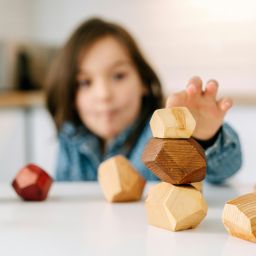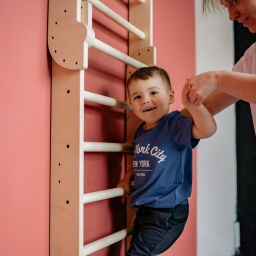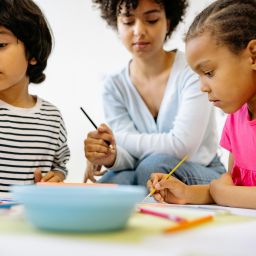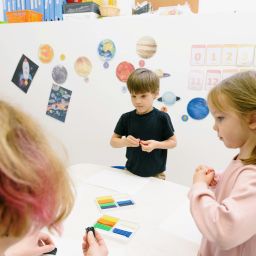
At First Habits, we focus on developing optimal childhood habits for a lifetime of wellbeing and success. But how do we go about making sure these habits are implemented in our children in a thoughtful and effective way? How can we make sure the instruction we are providing is well received and not overlooked or dismissed by our children? As parents, we know that having something important to convey to our child and getting them to listen are two different things. It can also be a challenge to balance high standards and positive behaviors while practicing unconditional love and connection with your child. On this platform, we often discuss important considerations like the science of habit building and the important foundation of motivation and discipline, but the reality is, these new behaviors will not be effective without a foundational connection with your child.
In her popular book, Good Inside, Dr. Becky Kennedy explains “Connection Capital” as follows:
“Connection capital – when we really connect with a child, see their experience, allow for their feelings, and make an effort to understand what’s going on for them, we build our capital. Having a healthy amount of connection capital leads kids to feel confident, capable, safe, and worthy. And these positive feelings on the inside lead to ‘good’ behavior on the outside – behavior like cooperation, flexibility, and regulation. So in order to create positive change, we have to first build connection, which will lead kids to feel better, which will then lead them to behave better. But note, behavior comes last. We cannot start there. We must start with connection.”
It’s often stated that the bonds we build early in life influence the trajectory of our life’s journey. When it comes to child development, this statement couldn’t be more all-important. By forging a strong, secure connection with your child, you’re constructing the most elevated foundations of childhood development. At the epicenter of this phenomenon lies an undeniable truth: the parent-child connection is the cornerstone for positively influencing a growing child’s behaviors and habits.
Connection with your child: The Beginning of the Upward Spiral
“The way we talk to our children becomes their inner voice.” – Peggy O’Mara, publisher of Mothering Magazine.
When a child feels connected and secure, there’s an instinctive alignment towards positive behavior. This First Habits philosophy has been supported by a multitude of studies. According to research from the Journal of Child Psychology and Psychiatry, children with secure attachments and connections display better problem-solving skills, enhanced emotional regulation, and higher self-esteem. These foundational aspects of child development are critical in determining their future habits and behaviors, and to your success in implementing the optimal skills you learn about from First Habits.
Think about connection as the center of the four-part habit loop that we presented in our foundation blog post here. Connection needs to be at the front and center of every discussion regarding positive childhood habit formation. Without a strong bond with your child each aspect of the habit formation loop will be less well attached.
Imagine this scenario:
Lucy, a dedicated mother of two, found herself constantly battling her 6-year-old’s reluctance to complete school assignments. Frustrated, she approached the issue with empathy instead of authority. One evening, she sat with her son, holding him close, and gently asked about his feelings towards schoolwork. To her surprise, he spoke about the overwhelming pressure of understanding certain concepts and his fear of disappointing her. Recognizing this, Lucy adjusted her approach, focusing on connection first. The result? Homework became a effort, filled with understanding and patience.
Just like Lucy, when parents prioritize connection, they start a positive feedback loop. This upward spiral is an escalating force of positive behavior driven by trust, leading to enhanced child development.
The flip side, however, holds true as well. The absence of connection can lead to a negative spiral. Children without a secure bond often feel isolated and misunderstood, leading to habits that are less than optimal. Without that secure base, they may seek affirmation in places and ways that aren’t beneficial. They might withdraw and reject their responsibilities and interactions or act out and express their frustration by behaving in defiant ways.
The Tapestry of Emotional Connection
While the physical wellbeing of a child is most often discussed in pediatrician’s offices and school halls, the emotional and psychological health of a child forms an intricate tapestry that often goes unnoticed. Every thread in this tapestry is a connection, an interaction, an experience. And central to this intricate design is the strong, secure bond between child and caregiver. This not only aligns with our pillar of emotional wellbeing, it is foundational to the very idea of successful and thoughtful implementation of First Habits.
When we at First Habits speak of habits, we speak of threads – daily actions, reactions, and emotions – that weave the fabric of a child’s future self. Let’s delve deeper into this fabric.
The Science Behind the Bond:
Neuroscience offers us a glimpse into the fascinating world of the developing brain. Early experiences, especially those related to emotional connections, stimulate neurons in the brain. Over time, these neural pathways solidify into patterns, forming the basis for behavior, emotional response, and yes, habits. Much has been published about Attachment Theory in recent years, and we won’t delve deep right now aside from this quick but relevant overview:
Secure Attachments: Studies have shown that children with secure attachments – a result of consistent, empathetic, and responsive caregiving – are more adept at handling stress. Their brains develop robust pathways for emotional regulation and social skills. They are more likely to form adaptive and healthy behaviors and relationships.
Insecure Attachments: Conversely, inconsistent, aggressive or neglectful caregiving can lead to insecure attachments. Such children may struggle with trust, empathy, and even self-worth. Their brain pathways mirror these experiences, often predisposing them to more challenging behaviors.
As renowned child psychologists Daniel Siegel and Tina Payne Bryson say in their bestselling book, The Whole Brain Child, “Of course children need structure and boundaries and to be held accountable for their behavior, but even as you maintain your authority, don’t forget to have fun with your kids. Play games. Tell jokes. Be silly. Take an interest in what they care about. The more they enjoy the time they spend with you and the rest of the family, the more they’ll value relationships and desire more positive and healthy experiences in the future.”
The tapestry we weave now, through daily habits, emotional connections, and consistent caregiving, will determine the strength, resilience, and beauty of the fabric of their future selves. Let us remember that the foundation of all habits, behaviors, and actions rests on the secure, unwavering connection they share with us.
From Neural Pathways to Daily Pathways: Making it Practical
Understanding the neuroscience is one thing, but how does this translate to the daily grind? Every mealtime negotiation, bedtime story, or park visit is an opportunity to reinforce these neural pathways, to add threads to the tapestry.
So, how do we foster these crucial connections? What are some ways we turn these ideas into daily actions (the ability to do this with each of the important topics we teach is an all important First Habits mindset). Here are a few strategies:
- Active Listening: It’s not enough to just hear your child; actively engage and listen to them. Understand their feelings and fears.
- Quality Time: Dedicate moments in your day, uninterrupted by technology or chores, exclusively for your child. Make this time fun and playful as possible. See our future post on Playful Parenting for more actionable ideas and tools on this topic.
- Empathy: Step into their shoes. Recognize and validate their emotions. Don’t dismiss them or outright object to their ideas, no matter how trivial or irrational they may seem. They might be the tip of a deeper matter, positive or negative, that your child does not yet know how to express. Sit with them in their feelings.
- Be Their Safe Haven: Let them know that irrespective of their actions or emotions, you’re always there for them. Don’t just tell them, instead show them, that your love and presence is not conditional based on how they behave or feel.
Conclusion: Elevate the Foundations
In the vast realm of childhood development, it’s tempting to focus solely on overt behaviors and habits. Yet, the undercurrent that truly drives these habits is the connection they share with their primary caregivers. As parents, it’s crucial to recognize this and prioritize building a strong, secure bond. By doing so, you’re not just positively influencing their current behaviors but setting them up for a lifetime of good habits. Again, please check out our future post on Playful Parenting for more actionable examples to aid in connecting with your child in meaningful and mutually enjoyable ways.
Through connection, you will be able to amplify the First Habits that will propel your child forward to success in their own lives. By aligning with research, understanding the importance of connection, and implementing the tools shared by First Habits, we can ensure that our children not only develop beneficial habits but also ascend the Upward Spiral of comprehensive child development.

















